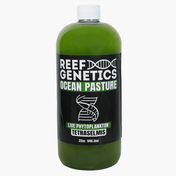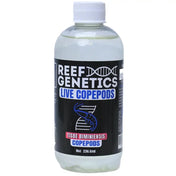Introduction to Saltwater Blennies
Blennies are hardy, active, and full of personality, making them a favorite among reef keepers. Found in tropical reefs worldwide, these fish spend most of their time perched on rocks, darting through crevices, or grazing on algae. Their small size, adaptability, and unique behaviors make them an excellent choice for both nano and larger reef tanks. While most blennies are peaceful community fish, some species can be territorial toward similar-looking fish. Their
Care Requirements
vary depending on their dietary needs, with some species specializing in algae control, while others prefer meaty foods.
Care Requirements
Care Level: Easy to Moderate Minimum Tank Size: 20 – 50+ gallons Smaller species (e.g., Tailspot, Bicolor) – 20-30 gallons Larger species (e.g., Lawnmower, Midas) – 40-50+ gallons Aquarium Setup: Requires rockwork and ledges for perching, grazing, and shelter.
Diet & Nutrition
Blennies have species-specific diets, with most being herbivores or omnivores, while some are carnivorous. Herbivorous Species (Algae Grazers): Lawnmower Blenny, Tailspot Blenny Thrive on natural algae growth, nori, spirulina, and algae-based pellets Omnivorous Species: Bicolor Blenny, Midas Blenny Accept both plant matter and meaty foods Carnivorous Species: Some blennies prefer a protein-rich diet of mysis shrimp, brine shrimp, and small crustaceans Providing a balanced diet ensures optimal coloration, energy levels, and long-term health.
Lifespan & Growth Rate
Lifespan: 4-6+ years Growth Rate: Moderate – Most species stay under 5 inches Blennies are long-lived for their size, making them a low-maintenance but rewarding addition to a reef tank.
Temperament & Compatibility
Temperament: Peaceful to Semi-Aggressive – Some species can be territorial toward similar fish Reef Safe? Yes, but some may nip at corals or clams Blennies are typically peaceful but may become aggressive toward fish with similar body shapes, such as gobies or other blennies. To minimize aggression: Keep only one blenny per tank, unless in a large system with multiple territories. Avoid housing them with larger aggressive species that may bully or outcompete them for food. Most blennies ignore corals, but some species—like the Bicolor Blenny—have been known to nip at fleshy corals when underfed.
Common Challenges & Considerations
Jumping Risk: Blennies are notorious jumpers—a tight-fitting lid is strongly recommended. Algae Dependency: Herbivorous species require a steady source of algae to remain healthy. A well-established tank is ideal before introducing an algae-grazing blenny. Territorial Behavior: Can be aggressive toward similar-looking fish or other bottom dwellers in smaller tanks. Water Conditions Temperature: 74-80°F dKH (Alkalinity): 8-12 pH: 8.1-8.4 Specific Gravity: 1.020-1.025 Blennies adapt well to stable reef conditions but require a well-oxygenated tank with moderate water flow.
Color Varieties & Popular Species
Blennies come in various colors and patterns, often featuring striking facial markings and expressive eyes. Popular species include: Lawnmower Blenny (Salarias fasciatus) – Excellent algae grazer with a mottled brown appearance Tailspot Blenny (Ecsenius stigmatura) – Small, peaceful, with a bright orange tail spot Midas Blenny (Ecsenius midas) – Golden-yellow body, known for its eel-like swimming motion Bicolor Blenny (Ecsenius bicolor) – Half purple, half orange, can be more aggressive than other species
At Top Shelf Aquatics, we take pride in ensuring your order arrives safely and in perfect condition. Here’s everything you need to know about our shipping process:
Livestock Shipping Details
- Flat Rate Shipping:
- $39.99 Out of State
- $34.99 Florida (In-State)
- Orders over $299 ship FREE!
- NO FREE Shipping during Sale Events
- Shipping Days: The calendar during checkout determines when your livestock order will arrive. Normally we ship Monday - Thursday via FedEx Priority Overnight.
Orders placed by 2 PM EST Monday - Thursday ship the same day. Orders placed after 2 PM or on Fridays will ship the next business day. - Delivery Times: Most packages arrive by 10:30 AM EST, though remote areas may experience later deliveries.
We take every measure to protect your livestock, including specialized packaging to maintain temperature and safety during transit.
Dead on Arrival (DOA) Policy
In the rare event of a DOA, you must submit a DOA Request within 2 hours of delivery (FedEx posted time). Once submitted, we will issue a replacement or store credit for the livestock. Please note:
- Shipping costs are not included in the credit.
- Refunds are not offered for livestock or shipping.
While we cannot be held responsible for delays caused by mechanical or weather issues, rest assured we’ll do everything possible to make it right!
Reef Guard Protection Plan
For ultimate peace of mind, upgrade to our Reef Guard Protection Plan. With Reef Guard, you’ll enjoy:
- Extended Livestock Guarantee: Coverage for up to 5 days.
- Priority Resolutions: Hassle-free claims with fast resolutions.
- Weather & Shipping Delay Coverage: Includes FedEx lost packages and damages.
Shipping Restrictions
- We currently ship livestock only within the continental U.S.
- Note: Due to Hawaii state law, we are unable to ship corals to Hawaii.
Now’s the perfect time to prepare your aquarium for its new additions. Consider doing a water change and ensuring space is ready. Check out our YouTube channel for detailed care instructions for your new corals!
For any questions or concerns, feel free to reach out to our support team. We’re here to help make your reefing journey a success!
5 Day Reef Guard
Temp-Control Box
Priority Overnight
Expert Care Support




















